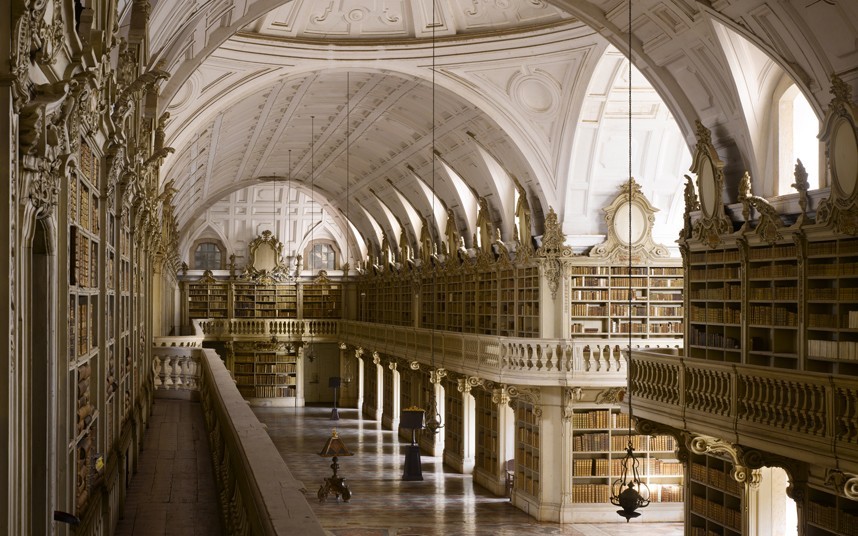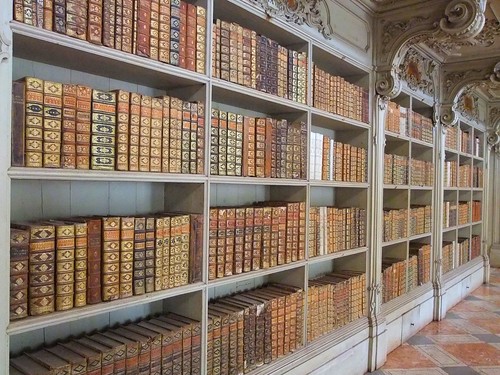Mafra Palace Library, Portugal
From The Telegraph:
More about the library and the colonial history behind its creation under the cut.Since its opening in 1771, the Mafra Palace Library has been home to a colony of tiny bats; they roost behind the cases in winter, and in the orchard outside in the summer, swooping in during the night to eat insects which would otherwise damage the books.
From the Boston Globe:
In a new book, "The Library: A World History," author James Campbell and photographer Will Pryce survey the world's libraries... The book is full of interesting asides, including the fact about the bats, which live at the Biblioteca Joanina and the Mafra Palace Library in Portugal. In an email, Campbell explained that the bats, which are less than inch long, roost during the day behind "elaborate rococo bookcases" and come out at night to hunt insects which otherwise would feast on the libraries' books. The price of this natural insect control is paid in scat: The bats, Campbell writes, "leave a thin layer of droppings over everything. So each morning the floors have to be thoroughly cleaned...and the furniture has to be covered at night."Official website of the Palácio Nacional de Mafra:
Some rare works furnish its shelves to this day, as incunabula (books printed until 1500) like the Nuremberg Chronicle (1493), and other precious books as the Theatrvm Orbis Terrarvm by Ortelius (1595), the famous Nuremberg Chronicle and the firts enciclopidiae - known as Diderot et d'Alembert.Also, a nucleus of scores from musicians such as João de Sousa Carvalho or Marcos Portugal, composed expressly to be played on the Basilica's six organs.From Wikipedia, which does not include any inline sources in this section:
Attesting its importance, a Papal bull of Pope Benedictus XV, from 1745, allows this Library to shelter the Index of prohibited books and forbids under excommunication “to anyone of any state or condition, in any time or in any way, to take, remove or lend from the Library without the permission of the Portuguese King, any printed books or manuscripts inhere stored”.
The Library is open to scholars, researchers, historians or occasional readers over 18 years, by appointment.
Besides natural techniques of conservation for the books, such as the lack of space between the wall and the book (so it doesn't create humidity), there are also a few bats that inhabit this library eating any insect that could destroy this invaluable treasure. The bats are kept in boxes that are placed under the bookshelves. At night, the boxes are opened and the bats feed themselves 500 insects, equivalent to the double of their weight.
The Library was used in [the TV miniseries] Gulliver's Travels (1996) as the Great Chamber of War for the Emperor of Lilliput.
Initially it was a relatively small project for a friary of 13 Capuchin friars, who were to observe strict poverty. However, when the flow of gold from the Portuguese colony of Brazil started to arrive in Lisbon in abundance, the king changed his plans and announced the construction of a sumptuous palace along with a much enlarged friary. This immense wealth allowed to king to be a generous patron of arts.Colonial Brazil gold cycle:
The discovery of gold was met with great enthusiasm by Portugal, which had an economy in disarray following years of wars against Spain and the Netherlands. A gold rush quickly ensued, with people from other parts of the colony and Portugal flooding the region in the first half of the 18th century. The large portion of the Brazilian inland where gold was extracted became known as the Minas Gerais (General Mines). Gold mining in this area became the main economic activity of colonial Brazil during the 18th century. In Portugal, the gold was mainly used to pay for industrialized goods (textiles, weapons) obtained from countries like England and, especially during the reign of King John V, to build magnificent Baroque monuments like the Convent of Mafra. Apart from gold, diamond deposits were also found in 1729 around the village of Tijuco, now Diamantina.
In the hilly landscape of Minas Gerais, gold was present in alluvial deposits around streams and was extracted using pans and other similar instruments that required little technology. Gold extraction was mostly done by slaves. The Portuguese Crown allowed particulars to extract the gold, requiring a fifth (20%) of the gold (the quinto) to be sent to the colonial government as tribute. To prevent smuggling and extract the quinto, in 1725 the government ordered all gold to be cast into bars in the Casas de Fundição (Casting Houses), and sent armies to the region to prevent disturbances and oversee the mining process. The Royal tribute was very unpopular in Minas Gerais, and gold was frequently hidden from colonial authorities. Eventually, the quinto contributed to rebellious movements like the Levante de Vila Rica, in 1720, and the Inconfidência Mineira, in 1789.Colonial Brazil: the gold cycle pg 196-197
In 1701 the king prohibited communication or transportation of cattle or foodstuffs from Bahia to the ‘mines of São Paulo’, or commerce in the opposite direction. Insufficient numbers of enforcement officers, coupled with the virtual impossibility of patrolling the vast areas of the hinterland, limited the effectiveness of such orders. In 1704 the crown forbade the re-export from Bahia to the mines of commodities imported from Portugal. Such restrictions were equally ineffectual; the lure of higher profits from sales in the mining areas was inducement enough to lead cattle drovers and merchants to evade controls and even to engage in hand-to-hand fighting with enforcement patrols rather than renounce their trading practices. […]
The crown also acted to protect the society and economy of Portugal from the potentially disastrous results of an uncontrolled gold rush. Restrictions were placed on the numbers and types of people whom captains were permitted to transport to the New World. By 1709 the impact on Portugal’s population, especially in the northern provinces, forced the king to reiterate earlier orders that potential travellers must have passports, obtainable from the secretary of state in Lisbon or, in the case of travellers from Oporto or Viana do Castelo, from the respective governors. Foreigners were only permitted to travel to Brazil if they could furnish evidence that their business was legitimate and posted bond before leaving Portugal or guarantee their return on the same fleet. Later this bond had to be increased because experience showed that windfall profits in the mining areas led many to forfeit their bond rather than return. Similarly, although clerics and friars were forbidden to travel to Brazil without the prior consent of their superiors or prelates, some signed on as ships’ chaplains, while others obtained the requisite authorization for a temporary visit to Brazil for the collection of alms and simply failed to return. Despite severe penalties (1709) imposed on ships’ captains found guilty of carrying prostitutes, many made their way to Brazil. There was always a way to gain passage, even if it were as a cabin boy or sailor, on payment of ten or fifteen gold coins. Measures were not strictly enforced as ports of departure
Oporto was notorious for the laxness of its authorities. In 1733 three ships from Oporto arrived in Bahia carrying over 700 passengers without permission. In 1742 the viceroy, the Conde das Galvêas, noted the large numbers of migrants to Brazil from Portugal and the Atlantic islands. Their destinations were Bahia, Pernambuco, Maranhão, and especially Rio de Janeiro as affording quickest access to the mining areas. He estimated that some 1,500 to 1,600 persons left Portugal annually for Brazil and that the majority went to the mines. Because so few returned to Portugal, he sounded a warning note on the prejudicial effects such migration could have on the mother country.
 |
| (Photo by Xavi Llunell via about portugal) |




No comments:
Post a Comment